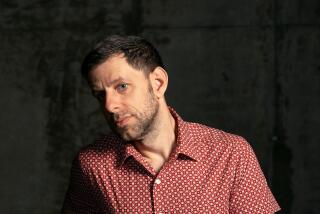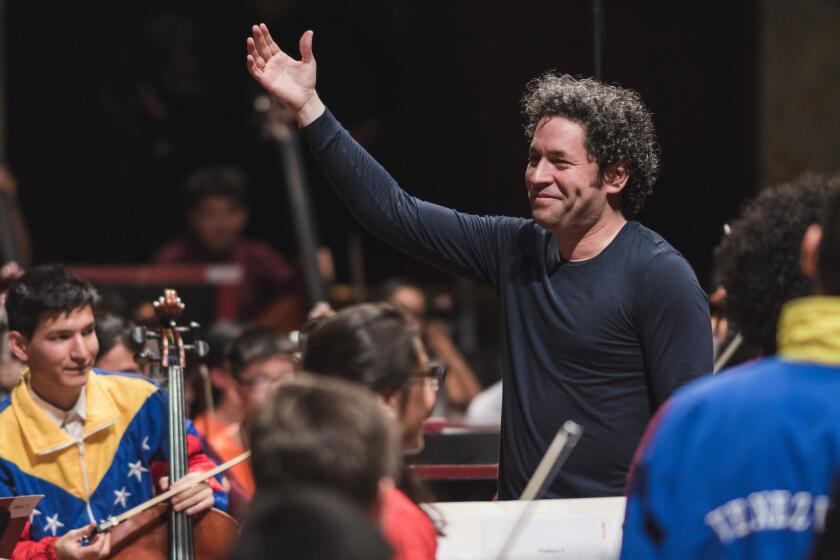L.A. Opera’s new CEO works to keep stage lights on, audiences coming
- Share via
For the past 12 years, the public face of Los Angeles Opera has been Plácido Domingo, the famed tenor who serves as general director. But the person who manages the company on a daily basis — the person whose job is to oversee every aspect of daily operations, including ticket sales, season planning, the bottom line — is a much less recognizable and celebrated figure.
Christopher Koelsch assumed the role of L.A. Opera’s president and chief executive officer in September. The appointment, announced earlier this year, marks a career high for the 41-year-old Koelsch, who joined the company in 1997 and has steadily worked his way up the ladder.
His appointment comes at a crucial time for L.A. Opera, which turned 25 years old last year and is the fourth-largest opera company in the country. The organization continues to work its way out of debt while also testing new waters, including a dynamic ticket pricing model that began this season.
PHOTOS: L.A. Opera through the years
“We’re trying new things and sorting out what works from what doesn’t work,” Koelsch said in his spare but tastefully decorated office at the Dorothy Chandler Pavilion. Koelsch is a reserved and somewhat distant interview subject. He has a tendency to speak in generalities. In a profession filled with colorful impresario types, he cuts a conservative figure — calm, deliberate, not easily flustered.
“My responsibility from the first day I was hired was to remove obstacles toward artists creating the best work on stage,” he said. “The number of obstacles has expanded. Now every aspect of my day-to-day life, I have to worry about union negotiations, IT infrastructure, donor relations....”
The list goes on and on. At the end of the day, he said, he is responsible for giving Domingo “the opera house he wants.”
Domingo said by phone that the company has been weathering “a crisis moment — we are hopefully coming out of it. We all hope we are finished with that period.” He said L.A. Opera will seek out more co-productions with other companies on new stagings to minimize costs.
Koelsch addressed the financial difficulties L.A. Opera has faced in recent years. The company has been gradually paying back debt that it accumulated in the buildup to its $31-million production of Wagner’s “Ring” cycle four seasons ago. This December, its leadership expects to pay off the remaining $7 million of the emergency loan from Los Angeles County that it received in 2009.
Money to repay the loan has come from donor pledges and the final payments are being collected, according to Koelsch.
The financial burdens have forced the company to offer a reduced schedule of just six productions in each of its most recent three seasons, compared with a high of 10 productions in 2006-07. L.A. Opera had annual operating expenses of $38 million in fiscal 2011, according to financial documents. Five years ago, the company had annual expenses of close to $56 million.
“We got ahead of ourselves putting out product. We overbuilt for our audience,” said Koelsch. “We’re in a period of correction.” Adding to the challenges, he said, donations have suffered at the lowest levels, though higher-level donations remain “robust.” The most significant drop in donations was seen in households that typically contribute less than $250, he said.
L.A .Opera isn’t alone in its financial woes. A few prominent American opera companies are grappling with money trouble, including Seattle Opera, which recently announced it is facing a $1-million deficit and will make cuts in future seasons. New York City Opera continues to deal with multiple financial problems since decamping from Lincoln Center last year, according to Koelsch.
As the L.A. company regroups, Koelsh said it hopes to build up to as many as eight productions per season.
Another hope, albeit a longer-term one, is to spread opera productions more evenly throughout the season. In the past, the company has tended to schedule openings close together, to take advantage of scheduling for the musicians and chorus. The result was that “we were competing with ourselves for ticket sales,” said Koelsch. “We have our ear to the ground in terms of what the audience wants, and the audience wants a steady diet of opera throughout the year.”
This season, L.A. Opera introduced dynamic ticket pricing, which allows the company to charge lower prices on less popular nights and to charge a premium for more popular performances. For example, a recent check showed that a Wednesday evening ticket for the recent run of “Don Giovanni” cost $220 for certain front orchestra seats. A similar ticket cost $276 for a Saturday evening performance. (Under dynamic pricing the selling prices can fluctuate daily.)
Domingo said that dynamic ticket pricing was introduced in part to address the unique challenges of opera-going in L.A. “In New York, it’s a walking city. [The Metropolitan Opera] puts cheap tickets on sale the same day and people can just walk to the Met,” he said. In L.A., it’s more difficult for people to take advantage of deals. “We have to use a strategy to sell tickets at a good price at the last moment.”
L.A. Opera is also introducing an initiative that will provide 250 seats at minimal cost, or free in certain cases, to select community members for every performance.
Running an opera company is a high-stress job. Domingo described Koelsch as “relaxed” in the face of pressure. “There’s no panic, there’s no tension. In an opera house, there is something to be solved every day. But you don’t have anything to gain if people are nervous.”
Koelsch joined L.A. Opera 15 years ago as an assistant to Peter Hemmings, the company’s first general director. He has since worked in several capacities at the company, most recently as chief operating officer and senior vice president, overseeing the company’s artistic planning, marketing and other responsibilities.
His appointment marks the first time in five years — since former Chief Operating Officer Edgar Baitzel died in 2007 — that L.A. Opera has had a solely dedicated individual overseeing both the company’s artistic efforts and finances daily.
“Christopher knows that job from the bottom up,” said James Conlon, the company’s music director. “He knows every aspect, not from a pseudo-executive perch of someone who has come into the company from above. He knows everything from below up.”
Koelsch originally hails from the Boston area. By his own account, he used to have an accent so thick that when he went away to school, some of his classmates thought he was a foreign student. (He has since lost most traces of it.) He studied at Colgate University and the University of Michigan and worked at the Spoleto Festival USA and Opera Pacific before coming to L.A. Opera.
A Long Beach resident for many years, Koelsch moved to downtown L.A. in July, cutting his commute from one hour to six minutes, he said. He lives with his partner, Todd Bentjen, vice president of marketing and communications at the Segerstrom Center for the Arts in Costa Mesa.
Like many major companies, L.A. Opera has a tradition of producing new works by major composers. But new operas have been noticeably absent on L.A. Opera’s main stage in recent years. The company has not produced a new opera since “Il Postino” by Daniel Catan in 2010. The opera, starring Domingo, was a popular success for the company and was seen by about 17,000 at the Dorothy Chandler, said the company. It also aired on PBS and has been released on DVD.
But other new operas have been less successful for the company — “Nicholas and Alexandra” by Deborah Drattell in 2003 and “The Fly” by Howard Shore in 2008 met with negative reviews.
“We’ve had mixed success with [new operas],” said Koelsch. “Part of the struggle of opera companies at the moment is the amount of investment that is required, and the risks are so enormous.” L.A. Opera is exploring new operas, Koelsch said, but he declined to elaborate.
He said recent audience feedback shows some people are more interested in experiencing opera in a more traditional, historical manner; others are more interested in adventure and new experiences, but the majority of audiences want a mixture of both, which is what we try to provide over the long term.”
For the time being, the company is looking to create a nimbler, more agile public image. Its new Off-Grand series, announced this year, will supplement its main stage season by bringing small-scaled performances to venues around the county.
“We want to be able to introduce people to opera in ways that will seem less intimidating,” said Koelsch.
“Opera is an acquired taste — and it requires sustained exposure.”
More to Read
The biggest entertainment stories
Get our big stories about Hollywood, film, television, music, arts, culture and more right in your inbox as soon as they publish.
You may occasionally receive promotional content from the Los Angeles Times.











